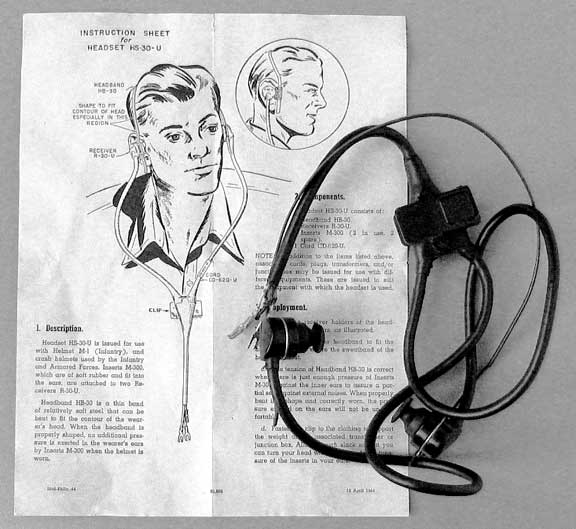Sonotone Corporation History
By Roger Russell
These pages are
copyrighted.
No portion of this site may be reproduced in whole or in part
without written permission of the author.
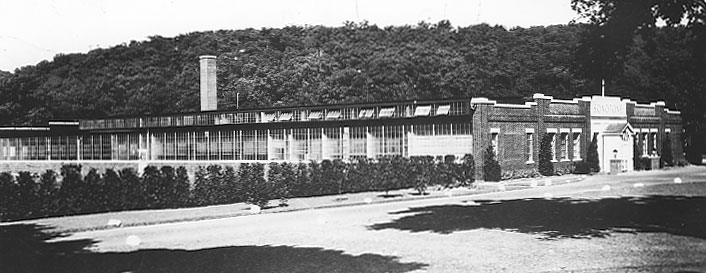
The
home of Sonotone in Elmsford, NY, housing Laboratories and Manufacturing Plant
Photograph from 1942
![]()
Here's my collection of information on Sonotone. As far as I know, this page contains the only information about the history of this important company. Much more is needed to fill out a complete history, particularly in the tube, hearing aid and battery areas. Most of the material on these pages comes from the eight years I spent as an audio product engineer in the Electronic Applications Division. Any additions, corrections or suggestions are very welcome.
|
What is on these Sonotone pages ? |
|||
![]()
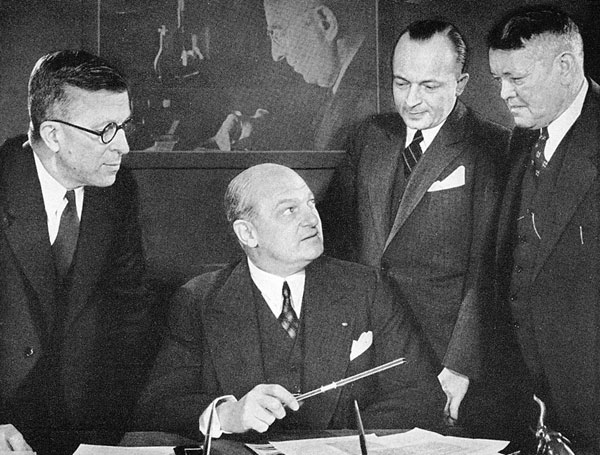
In the March 10, 1940 issue of Life magazine Sonotone had a full page ad with a picture of the "spark plugs" in America's war on deafness. (left to right)--Dr, Fred W. Kranz, research consultant, Dean Babbitt, president, Dr. Herman Scheibler, research director and Captain O. E. Marvel, Audiometer division. The portrait in the background hung in the Sonotone facilities and is of the "late" Hugo Lieber (born in 1868 in Germany, died 1936). Sonotone was established and incorporated in 1929 by Hugo Leiber as an outgrowth of a corporation to distribute Siemens hearing aids. . He invented the revolutionary bone conduction receiver in 1932. It enabled the deaf to hear through the bones in the head directly to the internal hearing organ. In 1934 it was advertised in the National Geographic as the Leiber Oscillator. Readers were invited to send for a free copy of "Science's Newest Hearing Technique." An improved bone vibrator was patented by E. H. GGreibach and Sonotone became the licensor for this in 1934. Sonotone Corporation was originally located at 19 West 44th Street, New York, New York but moved to Elmsford, NY in May 1937.
Dean Babbitt (left), Sonotone’s President,
who has frequently been called one of the country’s greatest creative salesmen,
is a rare combination of idealist and doer. Not the least of his many-sided
talent is his capacity for attracting exceptional men as his co-workers. Far
from a one-man enterprise, therefore, is the Sonotone organization which he has
directed since 1936 as president. For three years prior then he was its Vice
President and General Sales Manager, coming to Sonotone after a long and
brilliant career, including the sales direction of such nationally known 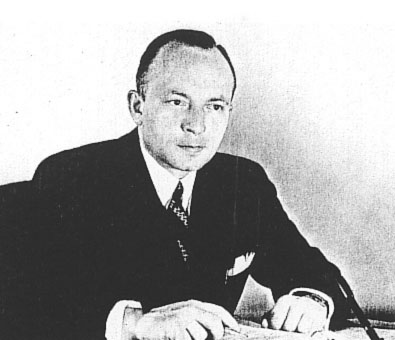 organizations as L. C. Smith & Corona Typewriters,
Inc., Remington Rand, and the Safe Cabinet Company. In stating his credo as
Sonotone’s chief executive he declares: “Management has three bosses; first and
foremost the hard of hearing public, after which come the organization itself
and its stockholders. He was president until October 1946.
organizations as L. C. Smith & Corona Typewriters,
Inc., Remington Rand, and the Safe Cabinet Company. In stating his credo as
Sonotone’s chief executive he declares: “Management has three bosses; first and
foremost the hard of hearing public, after which come the organization itself
and its stockholders. He was president until October 1946.
In 1937 the Audioscope, a master hearing aid device for carbon aids, was introduced. In 1952, the first hearing aid using a junction transistor was introduced by Sonotone.
Herman H. Scheibler, Ph.D., (right) Vice President and Research Director since 1936, Joined Sonotone in 1933 as Central European Distributor with supervision over Sonotone activities of agents in 14 countries. He established his own laboratory in Geneva and made numerous contributions to product development. Scheibler served on the University of Budapest Physics facility and in the laboratories of European industries. He installed the first radio broadcast station in Hungary and founded first radio club in that country.

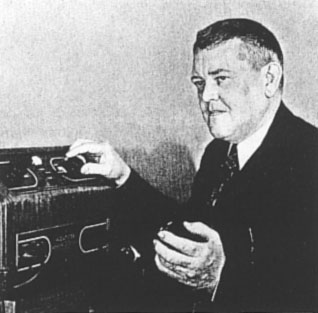 Captain Orin E. Marvel (left) was in charge of the
Audiometer Department starting in 1938. For 9 years, he had conducted his own
business as specialist in sound installations, audiometers. Previously, Marvel
was in the U.S. Signal Corps and aircraft communications research and 11 years
with Bell Laboratories. Marvel passed away in March of 1941 at the age of 55.
Captain Orin E. Marvel (left) was in charge of the
Audiometer Department starting in 1938. For 9 years, he had conducted his own
business as specialist in sound installations, audiometers. Previously, Marvel
was in the U.S. Signal Corps and aircraft communications research and 11 years
with Bell Laboratories. Marvel passed away in March of 1941 at the age of 55.
At the right is the Marvel All-Frequency Audiometer including headphones and bone conduction unit. One dial is for pitch and the other dial is for loudness.
Back in 1931, Marvel had begun using a variable frequency tone oscillator called the “Oratone” to treat persons who were hard of hearing. Headphones were used and hearing was tested for left and right ears. If the patient could not hear frequencies at the maximum volume of the machine, a bone conduction reproducer was placed on the forehead or on the mastoid bone behind the ear. If the patient still could not distinguish between different frequencies, then he was advised that nothing could be done to improve his hearing. When there is no bone conduction, it means the hearing nerves are inactive. Very few cases were of this type. After determining which frequency areas the patient had a hearing loss and making an “Oragraph”, the headphones were put on again and those particular frequencies to which the ear had become less responsive were impressed on the ear.
Repeated treatments were required at a cost of $2.00 per treatment and new charts were $5.00. Out of 80 patients, the average treatment per patient was 37.9 times. Average improvement per patient was 50.3% and average improvement per treatment was 1.32%. The treatments were painless and no surgery of any kind was needed to make the improvements. For those who stopped treatments and lost hearing again, a hearing aid was the answer
Orin E. Marvel was awarded patent number 1,761,530 “System for Amplifying Radiant Energy Oscillations” on June 3, 1930. It was applied for on August 23, 1924. It was assigned to the General Motors Radio Corporation of Dayton, Ohio. It provided a means of increasing the effectiveness of the electron discharge devices when used for a double purpose. It was to be used for both audio and radio frequency oscillations.
A second patent number 1,929752 was awarded to him on October 10, 1933 titled “Variable Frequency Oscillator”. It was applied for on April 17, 1931. The frequency of oscillations could be varied without changing the output and the output could be varied without changing the frequency. The oscillator covered the normal audible frequency range.
![]()
Typical Subject used for Full-Page Life Magazine Advertisements.
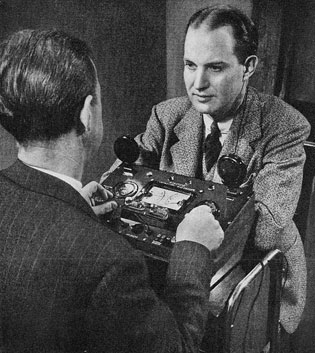
Lecturing to more than 35,000 people each
year, Mr. Paul S. Watson, curator of astronomy in a Baltimore 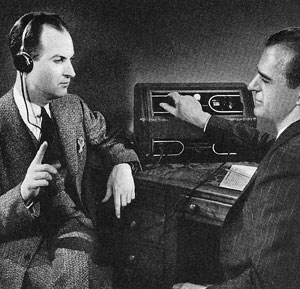 scientific institution, must answer hundreds of
questions from his audience. The Sonotone Audioscope at the left enables
Consultant Starkey to pick from a possible1500 adjustments. The Audioscope is a
fitting device used to adapt the hearing aid to the customer's individual
needs. He also taught Mr. Watson how to use it most effectively and was
available day and night to make sure good hearing was always available.
Although Sonotone designed and manufactured the hearing aids, it was the
Sonotone dealer, or consultant, that interfaced with the customer. The photo at
the right shows how a Sonotone a consultant is uses a Sonotone continuous tone
audiometer to measure a Mr. Watson’s hearing loss.
scientific institution, must answer hundreds of
questions from his audience. The Sonotone Audioscope at the left enables
Consultant Starkey to pick from a possible1500 adjustments. The Audioscope is a
fitting device used to adapt the hearing aid to the customer's individual
needs. He also taught Mr. Watson how to use it most effectively and was
available day and night to make sure good hearing was always available.
Although Sonotone designed and manufactured the hearing aids, it was the
Sonotone dealer, or consultant, that interfaced with the customer. The photo at
the right shows how a Sonotone a consultant is uses a Sonotone continuous tone
audiometer to measure a Mr. Watson’s hearing loss.
![]()
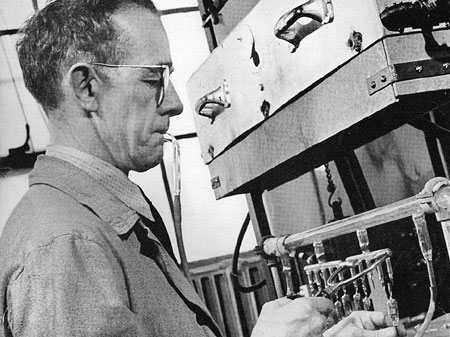
Sonotone developed and built the tiny vacuum tubes needed for the amplifiers in the hearing aids. Shown above is a finished tube that has just been released from the glass umbilical behind it.
Sonotone had a monthly publication titled HEAR.
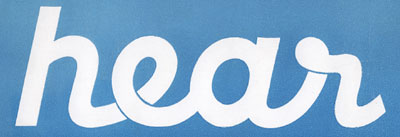

Sonotone pictured in the March, 1943 issue of Hear.

Here is a panoramic view of the home office and White Plains employees who gathered to honor Dean Babbitt’s tenth anniversary with Sonotone. They are shown above as they attended the flag presentation ceremony. From the July 1943 issue of Hear.
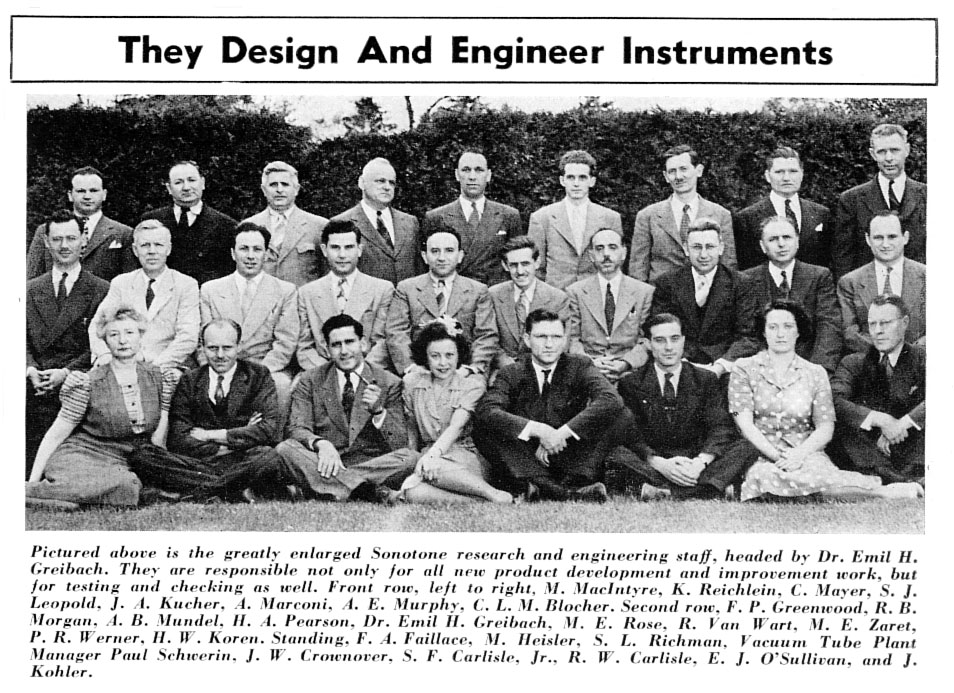
Here is a picture from the July 1944 issue if Hear
There are several people I remember from my time of employment of 1959 to 1967 who were still at Sonotone. Front Row Agnes E. Murphy. Second row August B. Mundel and Harry A. Pearson. Standing: Frank A. Faillace and Sam L. Richman
During World War II Sonotone prospered with defense contracts. These products ranged from communication devices to vacuum tubes.
|
|
|
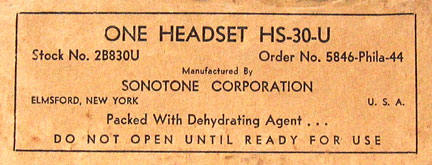
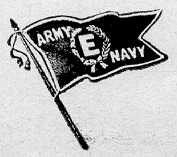 In 1944, the U.S. Signal Corps gave Sonotone the job of making radio
headsets for the fighting forces. The new headset had to be cut down in size to
fit under the Army's new battle helmet and work in any climatic conditions. It
also had to provide clear hearing with many different kinds of noise in the
background. Sonotone won the coveted Army and Navy "E" award. They
were manufactured at the Sonotone plant in White Plains, NY. Irving Schachtel
in the picture would later become president of Sonotone.
In 1944, the U.S. Signal Corps gave Sonotone the job of making radio
headsets for the fighting forces. The new headset had to be cut down in size to
fit under the Army's new battle helmet and work in any climatic conditions. It
also had to provide clear hearing with many different kinds of noise in the
background. Sonotone won the coveted Army and Navy "E" award. They
were manufactured at the Sonotone plant in White Plains, NY. Irving Schachtel
in the picture would later become president of Sonotone.
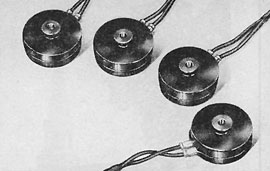 The knowledge gained in working with the Signal Corps
Technical Staff on this radio headset enabled Sonotone engineers to develop a
new principle of frequency control to make hearing easier and smoother. Using
the frequency control principle, Sonotone engineers designed a new series of
midget air conduction receivers (right). They enabled the Consultant to fit a
Sonotone hearing aid much more exactly to an individual's hearing loss.
The knowledge gained in working with the Signal Corps
Technical Staff on this radio headset enabled Sonotone engineers to develop a
new principle of frequency control to make hearing easier and smoother. Using
the frequency control principle, Sonotone engineers designed a new series of
midget air conduction receivers (right). They enabled the Consultant to fit a
Sonotone hearing aid much more exactly to an individual's hearing loss.
This success led them to rapidly become one of the leaders in the hearing aid industry. The post war years allowed Sonotone to provide a hearing aid to returning veterans that had incurred a hearing loss. Sonotone established a line of company owned and operated retail outlets. By 1942 there were 135 offices, including 23 in other countries. Sonotone could be also contacted at Elmsford, NY as well as 229 Yonge Street, Toronto, Canada and 144 Wigmore Street, London, W. 1, England. By 1944 there were 155 offices. At one time there were as many as 400 offices.
![]()
Hearing aid production was steadily increasing and to allow for expansion, production was moved from the Elmsford plant to new facilities on Hamilton Avenue in White Plains, NY, a few miles away. It was a rainy St. Patricks day in March, 1944 when the 400 employees were relocated. I recall that in 1957, I had worked at AT&T that was located up the street at 400 Hamilton Ave.
In the new production setup, a chassis starting at one end of the plant came out a finished hearing aid at the other end. The departments included crystal and microphone cup assembly, Vacuum tube terminal tinning and bending, microphone assembly, oscillator assembly, 531 instrument sub-assembly, 531 instrument wiring, 533 wiring and assembly, buffing and polishing room, and final testing of instruments with special electronic apparatus.
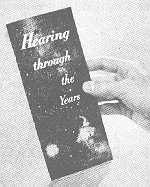 Interested persons could write for a free book titled
"Hearing through the years" explaining the details of Sonotone's
service and showing the safest road to better hearing. The hearing aids were
nationally advertised in Life magazine, Readers Digest, National Geographic and
network radio commercials. The company enjoyed a controlled market place with
extremely high revenues and profits.
Interested persons could write for a free book titled
"Hearing through the years" explaining the details of Sonotone's
service and showing the safest road to better hearing. The hearing aids were
nationally advertised in Life magazine, Readers Digest, National Geographic and
network radio commercials. The company enjoyed a controlled market place with
extremely high revenues and profits.
Other booklets were titled “The Twin Senses” copyright 1937 by the Sonotone Corporation. Of the five senses whereby man knows and enjoys his world, sight and hearing are to him the most vital. Another book was titled “Introduction to Lipreading” copyright 1941 by Sonotone. Further books in the series were “Educating your hearing,” Your Hearing and Your Health” and How to Improve Your Speech.”
![]()
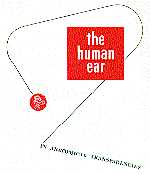 Dean Babbit, president of Sonotone, encouraged the
publication of the book The Human Ear: In Anatomical Transparencies. It
was published under the auspices of Sonotone Corporation in 1946. Stephen L. Polyak,
M.D., and professor of anatomy, the University of Chicago, wrote the
descriptive text. Miss Gladys McHugh, medical illustrator, the University of
Chicago Clinics, made the anatomical transparencies and illustrations that
formed the main idea of the book. These were based on numerous dissected
specimens prepared by Delbert K. Judd, M.D., and assistant professor
otolaryngology, the University of Chicago.
Dean Babbit, president of Sonotone, encouraged the
publication of the book The Human Ear: In Anatomical Transparencies. It
was published under the auspices of Sonotone Corporation in 1946. Stephen L. Polyak,
M.D., and professor of anatomy, the University of Chicago, wrote the
descriptive text. Miss Gladys McHugh, medical illustrator, the University of
Chicago Clinics, made the anatomical transparencies and illustrations that
formed the main idea of the book. These were based on numerous dissected
specimens prepared by Delbert K. Judd, M.D., and assistant professor
otolaryngology, the University of Chicago.
The bibliography contains several hundred references. The hard cover book has 136 pages measuring 8-3/4" wide and 11-3/4" high. There are 20 extremely detailed color transparencies measuring 8" wide and 10-1/2" high. Two separate cards are included with the book and are keys for the transparencies part 1 and part 2. T. H. McKenna, Inc New York, N.Y. distributed the book.
![]()
1953 Award
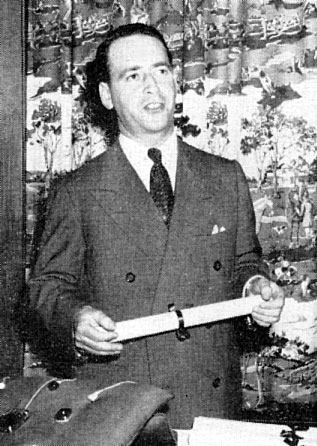 Dr. Irving I. Schachtel (an attorney;
bornMarch2, 1909, London, England; came to the US in 1914; joined Sonotone in
1931) He was president from 1946 to 1968. He continued the company success
story. In 1953 he was presented an Audio Engineering award for the 1010 hearing
aid. This was published in the June 1953 issue of Audio Engineering magazine.
Text is as follows:
Dr. Irving I. Schachtel (an attorney;
bornMarch2, 1909, London, England; came to the US in 1914; joined Sonotone in
1931) He was president from 1946 to 1968. He continued the company success
story. In 1953 he was presented an Audio Engineering award for the 1010 hearing
aid. This was published in the June 1953 issue of Audio Engineering magazine.
Text is as follows:
“Considering the mechanical and electrical features of all of the hearing aids studied, it is the unanimous opinion of the judges that the major effort in hearing aid design and production has been achieved by Sonotone Corporation in its Model 1010. The judicious use of a transistor in the output stage, where its high electrical efficiency is most advantageous, is commended. Cost of operation is reduced considerably below that of the all-vacuum hearing aid without sacrificing quiet operation. Also noted were desirable mechanical features such as separation of volume control from the on-off switch, and the sturdy plug connections between the instrument and the earphone, the accessory microphone, and the telephone pickup device. With respect to weight and compactness, the instrument compares favorably with all others studied.”
William G. Laffer was president from April 1968 to 1972 and W.T. Ylvasacker was president from June 1972 to November 1973.
![]()
Sonotone Then and Now
Sonotone employees belonged to a union. This included both production and engineering. Many production employees had been there for over 20 years and were entitled to 3 weeks of vacation, forcing production to close for 3 weeks in the summer. During a layoff, workers with seniority could "bump" other workers who had not been there as long and had lower pay. As a result, the higher paid workers remained and production costs increased.
Because of the high profit visibility within financial circles, Sonotone became a target of stock acquisition by many corporations. About 1965, Sonotone was bought by the Servel Corporation and was later owned by the Clevite Corporation. In April of 1969, the Astatic Corporation, a long time competitor, purchased the Audio Products line of Sonotone from the Clevite Corporation., This included the phonograph cartridge, needle and microphone products, production tools, dies and inventory of finished and semi-finished materials, as well as domestic patent rights. A year earlier, Astatic had purchased the Euphonics Corporation, also makers of ceramic cartridges and needles. Both Servel and Clevite drained the Sonotone assets.
Sonotone then merged with Gould-National batteries, Inc. to become Gould, Inc. in July 1969. In November 1973, Sonotone Corp was purchased by Charles Pindyck, Inc (Arthur R. Lorch, chairman), with Marilyn E. Costello the chief operating officer and Onel Bakiro general manager.
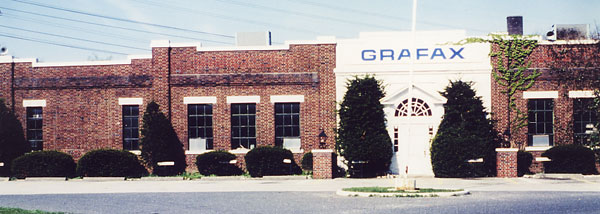
In 1970, two thirds of the old Elmsford building was occupied by Grafax and the remainder was occupied by Sonotone. Grafax manufactured specialized medical X-ray positioning machinery. They were associated with Machlett, manufacturers of X-ray tubes and occupied this space until at least 1979. This central portion of the E shaped complex had contained the Sonotone main entrance, executive offices, sales, purchasing and accounting.
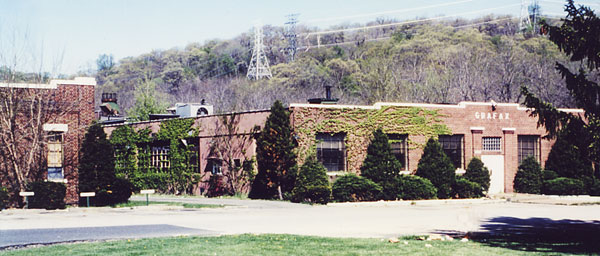
Formerly, the right hand or north building was the research area for battery chargers, tape heads, phono cartridges, drafting and speakers. It also contained a large machine shop and an Ozalid machine.

The south building contained the production lines and production management. By 1970, what remained of Sonotone was located in this section of the complex but that was soon to be vacated as well. The above three pictures were taken in May of 1979.
In 1979, former chief engineer Marty Molloy saw continued value in the name, and along with a few investors, purchased the name Sonotone and the remaining physical assets. It was reorganized as Sonotone International, Inc. at 109 Croton Ave., Ossining then moved to 37-A Old Albany Post Road, Ossining, NY 10562. Sonotone remained with a presence in the hearing aid industry, but at a reduced level. There remained a 1% marketplace for their body-worn products, including the behind-the-ear units. After Marty Molloy passed away, the company was apparently in limbo for several years.
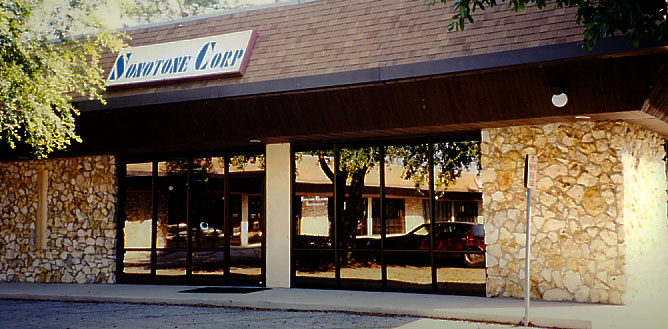
It was not until 1987 that Sonotone was purchased by Telstar Electronics, Inc., parent company of what was then Sonotone Corporation. It was located at the corner that is part of a small shopping center at 2290 North County Rosd 427, Suite 152, Longwood, FL. The windows were treated to reflect the heat from the hot afternoon sunlight. In 1992 John Adkin was named president. He came to Sonotone Corporation with 23 years of hearing aid experience, both manufacturing and dispensing. He had a degree in business administration from Florida State University. The product line included in-the-ear and in-the-canal style hearing aids utilizing the latest in micro electronic components and manufacturing techniques. This included programmable ROM chips for custom hearing correction that could be adjusted right in the office. Sonotone had a self-contained plastics laboratory which allowed products to be custom fitted for individual ears.
Sonotone Corporation was purchased by Paul Harford in 2001. The company remained in Longwood, Florida, which is just north of Orlando, until January 10, 2005 and then was moved to DeBary, FL. In August, 2005, I heard that Sonotone has closed the doors and was out of business. A contributing factor was competition from other hearing aid manufacturers.
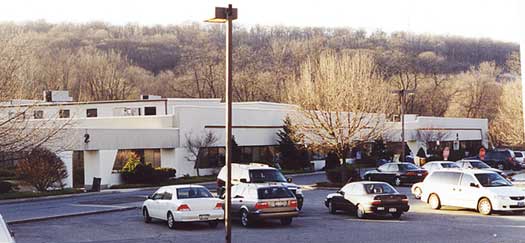
Today, the old Sonotone building in Elmsford has undergone a completely new face lift. It is now called the Elmsford Executive Park and is occupied by many different businesses. You would hardly recognize the building as it has been very nicely converted. What used to be a large front lawn is now a parking lot filled with hundreds of cars.
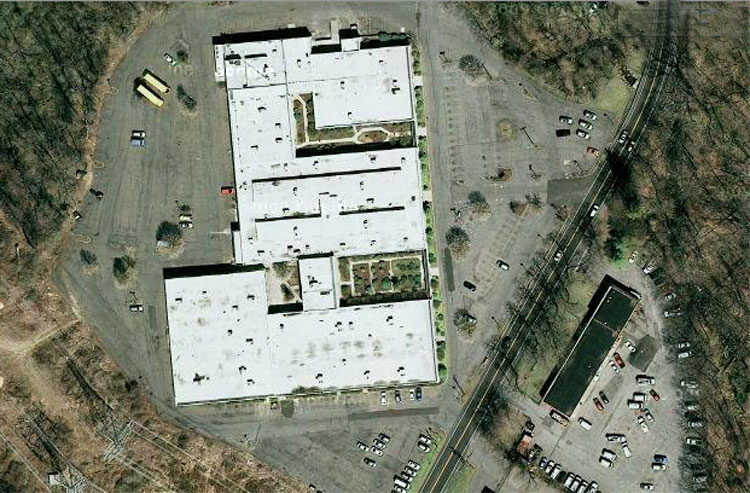
Here is an ariel view of the building in 2009. For those who are familiar with the area, the power lines are at the bottom left corner. The open spaces between the buildings are still there. Across the Old Saw Mill River Road at the right used to be where most of the employee parking was. This is at the bottom right corner. A traffic policeman was posted there during quitting time to direct traffic. There are now two new buildings there.
|
About This Site |
||
|
|
More text and pictures about Sonotone will be added as my research continues. Any comments, corrections, or additions are welcome. |
|
|
Email
to |
|
All
contents are copyrighted. |
